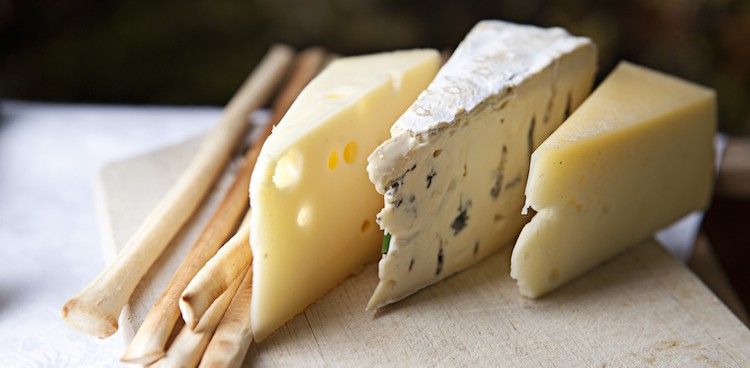
What happens when you store cheese in plastic wrap?
Good question! This is a hotly debated topic, and everyone has an opinion. I welcome the opportunity to shine a spotlight on the complexities of the answer.The effect that plastic wrap has on cheese varies depending on the type of cheese. The rind is the most important thing to consider. Bloomy rinds and washed rinds, both full of microbes going about their business of ripening the paste, are quite fragile and will have a tough time with plastic wrap. The wrap cuts off the precious oxygen supply these rinds need to be healthy. Long periods of time spent in plastic will kill off those friendly colonies, making the surface of the cheeses slimy and smelly—the wrong kind of smelly. The rind can become discolored, most noticeably a damp, rusty look on the bloomies.
Hard cheeses, rinded or not, can also suffer from plastic wrap due to light oxidation. The light that shines through discolors the paste and creates that nasty crayon-like off-flavor. That flavor is often blamed on the plastic itself, but I beg to differ. I chewed plastic wrap doing research for this article, both plain and heated up, and it is itself flavorless. No studies have been done on the interaction of the fat in the paste and plastic and whether that creates a bad flavor. The most obvious explanation to the conundrum of this dreaded off-flavor is light damage.
It is important to note that these things occur only with extended use of the plastic. While it’s not ideal, plastic remains the single most accessible answer to cheese storage. If you’re able to get it, cheese paper is a marvelous thing, offering oxygen access and reasonable moisture regulation for a short amount of time.
But the easy solution? Buy cheese in small quantities, often. Eat it and go buy more.
Special thanks to cheesemonger Liz Nerud of Kowalski’s for her answer!





Hello Michael!
Thank you for taking time to describe the protocols at your shop! I like the idea that you are so careful with your rinds. They do need to breathe, although some are sturdier than others. The main thing is to have an understanding of what the basic science is behind a given rind and give it what it wants!
Thank you for your comments on the date issue, I offered my perspective in my reply to our sister-in-cheese Gillian.
Take it cheesy,
Liz
Hello Gillian! Thank you so much for taking the time to reply to the article! It sounds like you have a lovely shop and your respect for the cheese is clear. Your customer service sounds lovely! I bet it’s a pleasure to shop at your place.
The procedures you describe sound very reasonable, and your advice to your customers is spot on! I appreciate that you are mindful of the dates, as is the other commenter, Michael. I use dates to assess the condition of the cheese, and take them as suggestions rather than the final word on whether a cheese is past its prime. As I described in my answer above, cheeses vary so greatly in their requirements for care, it is up to us as cheesemongers to carefully observe and nurture them.
Thanks again for your kind words!
Your friend in Cheese,
Liz
Cheesemonger in Switzerland here. All of my cheeses are stored in my display in cling film of course (otherwise clients can’t see them!) but I tend to to have the cut surfaces tightly wrapped and the rinds loosely wrapped with some gaps so the rinds don’t sweat. When customers ask how long they can keep cheese I also tell them to buy smaller amounts more regularly and let us professionals worry long term storage.
Re Gillians comment about dates, I generally ignore them. I’m more interested in the production date and use a guide from the producers about how the cheese might be at certain ages. The “Best Before” dates are the main reason for so much food waste – I often find a cheese is vastly improved at 2 – 3 months beyond the BBF date.
Regards from Zürich!
Michael
Hello Liz
I work as a cheesemonger for a store. We sell quite a variety ofcheeses and i find it so pleasurable when i cut portions of cheese on the clients request.
We have been using white cheesepaper but only last week we changed to brown. We wrap the customers cheese in this but the remainder of the cheese is wrapped in clingfilm including Bries, Delice De Burgoigne various cheddars and other soft cheeses, smoked cheese Lancashires etc etc.
Hopefully we are doing the right thing. The cheese never comes to any harm wrapped in this way.
They obviously have their dates which we are meticulous about!!!!!! We tell the customer to wrap the cheese really well before they place it in their fridge. We do try to encourage them not to wrap it in clingfilm as certain cheeses will ‘sweat’. It was great reading your article!!!!! More please.
Many thanks.
Gillian Hollingworth.